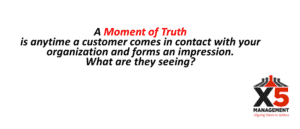Most business owners have dealt with frustrated or upset customers at some point. If you’ve been in business long enough, it’s virtually unavoidable. But what isn’t unavoidable is taking important steps to manage these situations and resolve the conflict.
There has never been a more important time to ensure customers are satisfied with your product or service. Most environments are very competitive, not only for customers but also for employees. Consumers appear less patient than they once were; perhaps it is a sign of the times or perhaps they are fed up with mediocre service levels.
Consider the following advice:
Upset Customers Don’t Have to Remain Upset
How do your team members or customer service reps react during this critical moment of truth for your business?
A moment of truth is “anytime a customer comes in contact with your organization and thereby forms an impression of it” (Jan Carlzon). Over time, these impressions ultimately set your business up for lasting success or great failure.
The good news is that you control your organization’s customer service approach. It must be embedded in the culture and emphasized in the training. Team members should think of customers as partners, who they want to help.
Bad Customer Service in Action
I was recently inquiring about a product at a local retail store.
I inquired with the sales associate to see if they carried the product I was looking for. He helped me for several minutes. Then, he suggests he will be right back to answer my question, but he drifts away to his computer before assisting other customers. After waiting for several minutes, I walk back over to the service counter to see if I can get his attention. I assume he is going to continue to assist me after he finishes with the customer he was speaking with. However, after he was done with the current customer, he continues to call up other customers and doesn’t come back to answer my original question.
I step in and ask if he had been able to look up the information I required. And the sales associate remarks, “Oh right, I forgot about that. We don’t carry that product right now.” That’s all he says.
I was frustrated by the way this situation was handled. Most likely, I’ll take my business to a competing store in a future situation. Make sure this type of poor service never happens in your business. The business won’t last as there are plenty of potential competitors willing to help dissatisfied customers.
Sound like something you’ve experienced with your own customer service?
I wouldn’t be on this store’s list of upset customers if they took steps toward resolving customer conflict.
A good strategy to resolve customer conflict will hopefully leave the customer with a positive memory of your encounter and as an advocate of your brand.
Remember that in many situations, upset customers don’t think of themselves as customers – they think of themselves as people who need your help!
5 Ways to Manage Frustrated Customers
Use these five steps to skillfully take charge of negative customer situations and salvage a potentially disastrous encounter.
- Focus on the situation only: Engage with the upset customer directly, giving them your full attention and solid eye contact.
- Let them vent: Hear the customer out before you step in. If you interrupt, they may need to repeat what they have already said.
- Empathize with the customer: Perhaps the most important step in resolving this conflict is letting your customer know that you “feel their pain.”
- Summarize their situation: Upset customers need to see and hear that you understand their level of frustration.
- Problem Solve: Agree on the problem, brainstorm options, agree on the solution and follow up on commitments made.
So, there you have it. Five effective strategies for dealing with upset customers. The notion of “the customer is always right” doesn’t always seem fair or even logical. But there is a reason behind it. Treating the customer as though they are right (and always with respect) goes a long way in boosting customer retention and satisfaction.
Learn more about customer service standards here.
How to Avoid Upsetting Customers
The best strategy is always to avoid situations that might upset your customers. Track any complaints and ensure the leadership team regularly strategizes to plan what the issues could be.
For example:
Customer service standards – in today’s competitive industry with customer expectations, training is imperative.
Wait times for products – be sure there is a follow up mechanism so that overpromising and underdelivering do not occur. A process must be in place that internal follow up occurs before a customer has to follow up on an expected delivery date.
Reliable vendors, or service providers – “blaming” the third-party is never an option. Every organization needs to consistently follow up with the level of standard and service they expect from third-party vendors to ensure consistent customer satisfaction.
Every industry is different, and with today’s supply chain delays, customer conflicts may arise as a result. Plan for the inevitable, just in case.
Staff training is the best strategy for anticipating and overcoming customer conflicts. How your employees engage and interact with customers is critical when these are unavoidable.
When Culture Counts
It may not always create customer empathy, but few customers do not realize that in many industries, short staffing is a current reality. We have all heard of the Great Resignation. There appear to be more jobs than people in customer service, hospitality, manufacturing, and many other industries. It is hard to understand, and I expect you have encountered this challenge as a consumer or as a leader.
Can you avoid it? Perhaps not 100%.
Consider your organizational culture, though. A culture that supports employee training and communication, including advancement opportunities, will always have employees that care more and find it easy to go the extra mile for their customers.
Your Culture is Your Brand – Get it Right




